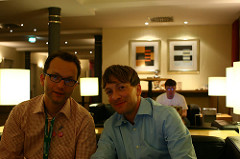update: based on the comments, I learned that the original idea “creating standards is altruistic” was wrong. It seems that altruism plays a role, but vendors gain a market advantage when implementing a standard first. Making good products that spread is another way to create a standard.
so, this is wrong for now:
Creating standards, as for example the W3C or the ISO does, is an deeply altruistic behavior and I think a hint that the people involved are altruistic.
A definition of altruistic is “Benefiting others without regard for one’s own needs or safety.”
Creating a standard is usually a process of endless and endless discussions, exchanging arguments, giving arguments for every decision, reworking drafts, fixing formulations, agreement, and discourse, and this process can last over years, and usually does last more than a year. The outcome is rather simple: a document describing the decisions in one simple manner. If you look at the HTML, HTTP and URI specs, you can read and understand them in a day. It took years from the first idea to write and improve them to their state, and it took a lot longer time, namely many years, to establish them as a standard.
Now, what is the benefit of creating a standard? For the author, nothing. The author doesn’t get paid for it (unless you charge for reading your standard, what many organisations do). You don’t get fame nor money, because you invested all your time into the standard, but not into your product, which can now by copied by everyone in the world by implementing the standard.
So, why do people do standards? I cannot say for you, but I work on them because I think that the world would suck very hard if we not had standards for some things. Think of having to switch to a different browser when looking at asian websites, like carrying around an platoon of power adapters so that you hopefully can suck electricity from whatever socket you are confronted with.
The opposite of making a standard is implementing the solution. Then you have it, your great solution, coded in executable binary, nothing can go wrong now. You are quick to do it, you don’t have to care much for documentation, and your customer is happy.
But imagine looking at a website hosted by an Internet Information Server (Microsoft) would mean that you have to use a Microsoft Operating System, or a Microsoft TV, or a Microsoft Phone. At first, there is no problem. But after others did the same, I would have to carry around many phones. So, clever people (who are often altruistic and may work for market leaders like Microsoft Corp.) see these problems beforehand and decide to sit down to make a standard, once sitting you notice that there are others seated next to you who feel the same.
Some say “the good things about standards is that there are so many of them to choose from”. This is not true, because for anyone in such situation of choosing, “good” is exactly not the way you feel, because you get this slight feeling deep inside, that your decision is shiny today, but sits down in some dark place and comes to bite your behind years later.
So, if you are stuck again while working on a standard, like me at the moment, and life is blackened by endless arguments and paperwork, think about why you started the whole thing.
And on the other hand, if you watch people like the W3C members sitting around in endless discussions about details, dissecting every piece of it and making a lot of seemingly useless paperwork, and you think to yourself “ha, I could do a better standard alone”, think twice. First of all, open your cupboard and get out your beloved assortment of travel power socket adapters for a short personal meditation about the stupidity of man. Then, think of the motivation of people writing standards: not money nor fame can be the reason, there is neither of it in it, they do it for you.
p.s. HM, the Queen of Britain, has honored Tim Berners-Lee again by giving him the Order Of Merit, putting him in one league with Florence Nightingale and Mother Theresa. I think this does not only honor him but also everyone wasting his life away for the W3C and technical standards in general. People travelling as much as the royals do, seem to know the irony of power sockets that look a bit unfamiliar compared to the plug you want to put in them, and cars that have their gear switch on the left hand side of you, adding to the irritation of driving them on the “wrong” side of the road. Feel free to comment.
p.p.s. perhaps I don’t get it because I am a complicated thinking Java programmer and not a witty Python hacker (like Gromgull), where the standard is set by best practice.













